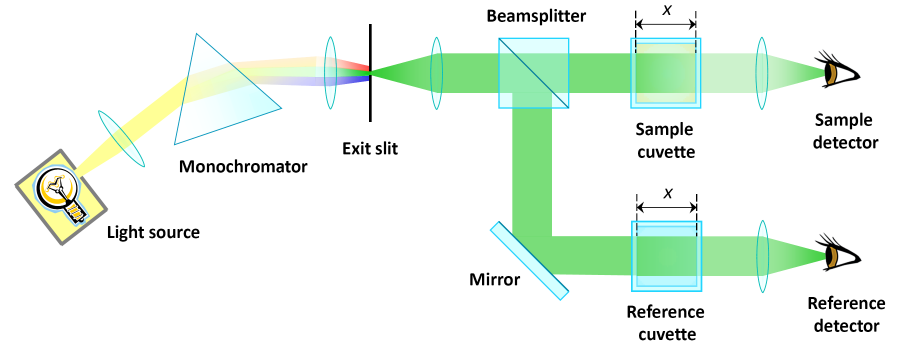4. Absorptie en verstrooiing
Absorptiefotometrie (3/6)
De nadelen van een fotometer met enkele bundel zijn inherent aan de tijdrovende metingen van het referentiemonster en het eigenlijke monster voor slechts één analyse. De inhoud van de cuvet moet worden verwisseld of zelfs de hele referentiecuvet moet worden vervangen door de monsterkuvet. Deze procedure leidt gemakkelijk tot onnauwkeurigheid van de optische uitlijning die niet altijd merkbaar is. Hierdoor ontstaat het risico op het meten van onnauwkeurige gegevens.
Het zou veel handiger zijn om gegevens voor beide kuvetten tegelijk te verzamelen. Dit vereist een uitlijning met twee optische paden.
De fotometer met dubbele bundel
Het licht van de monochromator wordt door een bundelsplitser in twee afzonderlijke bundels gesplitst. Nu hebben we twee bundels tot onze beschikking voor de twee cuvetten. Het doorgelaten licht wordt gemeten door twee fotodetectoren. Het oplosmiddel kan in de referentiecuvet blijven en wordt bij elke analyse onderzocht, net als de verschillende monsters.
In plaats van een bundelsplitser kunnen draaiende glaspanelen worden gebruikt. Deze zijn gedeeltelijk gespiegeld zodat het monochromatische licht afwisselend door de monsterkuvet wordt geleid en gereflecteerd om langs de referentiecuvet te gaan.
Men zou kunnen tegenwerpen dat de twee opstellingen niet langer identiek zijn. Dit was een voorafgaande voorwaarde voor gegevensanalyse zoals op de vorige pagina werd getoond. In dit specifieke geval vindt men twee verschillende lenzen en lichtdetectoren.
Het bezwaar is terecht. De verwachte verschillen in de afstanden kunnen echter door een truc worden opgelost. Beide cuvetten worden aan het begin gevuld met dezelfde referentievloeistof (meestal gezuiverd water) en de signalen van de detectoren worden gemeten. Dit wordt uitgevoerd voor alle golflengten waarvan de absorptiecoëfficiënten moeten worden geanalyseerd. De waargenomen afwijkingen van de signalen worden dus veroorzaakt door de verschillende stralenpaden en gevoeligheden van de detectoren.
De software van de fotometer leidt dan uit die afwijkingen factoren af die helpen om de signalen later te corrigeren zodat de dubbele bundels numeriek aan elkaar gelijk zijn. Deze elektronische signaalcorrectie wordt meestal 'autozero' genoemd.
Een volgende meting met de referentievloeistof in beide cuvetten zou een waarde rond nul voor de extinctie moeten opleveren. Dat is een test voor de juiste optische en elektronische afstelling van beide lichtwegen. Voortaan is de fotometer voorbereid op de analyse van de absorberende eigenschappen van monsters.
Op de volgende pagina zie je een moderne fotometer met dubbele bundel, zoals die in alle chemische en fysische laboratoria te vinden is.

